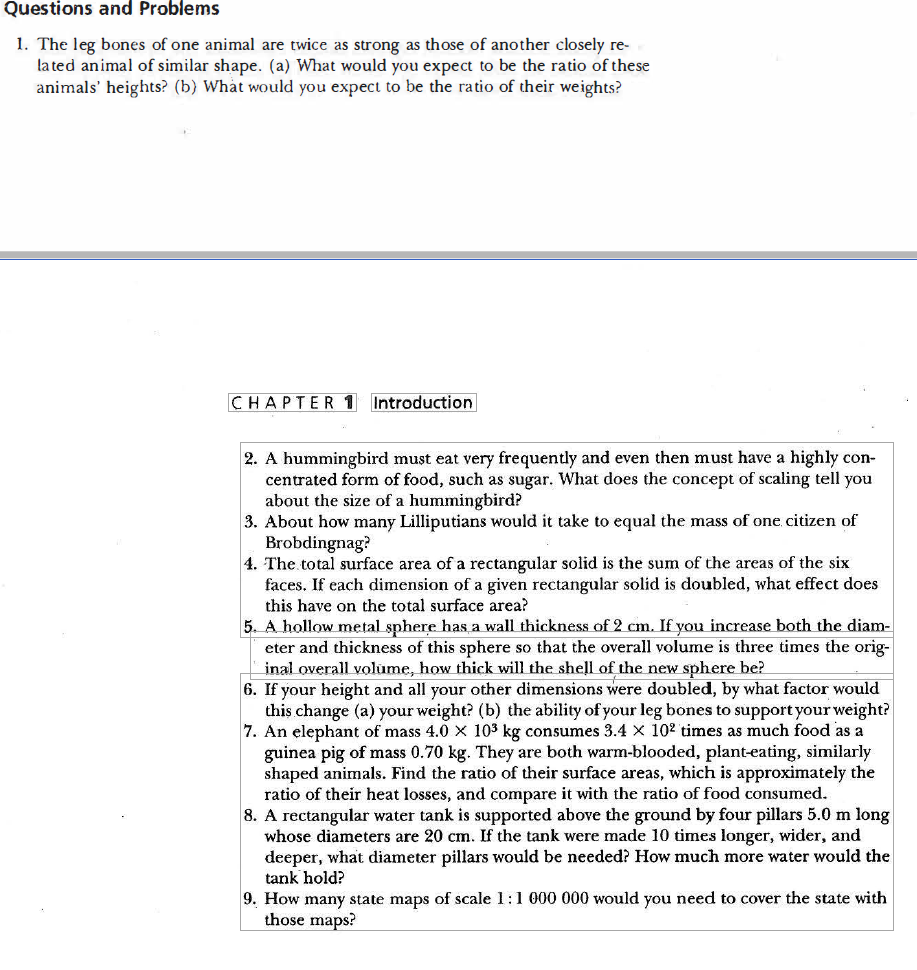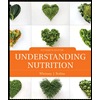1. The leg bones of one animal are twice as strong as those of another closely re- lated animal of similar shape. (a) What would you expect to be the ratio of these animals' heights? (b) What would you expect to be the ratio of their weights?
1. The leg bones of one animal are twice as strong as those of another closely re- lated animal of similar shape. (a) What would you expect to be the ratio of these animals' heights? (b) What would you expect to be the ratio of their weights?
Understanding Nutrition (MindTap Course List)
15th Edition
ISBN:9781337392693
Author:Eleanor Noss Whitney, Sharon Rady Rolfes
Publisher:Eleanor Noss Whitney, Sharon Rady Rolfes
Chapter12: Water And The Major Minerals
Section: Chapter Questions
Problem 1BCTQ
Related questions
Question

Transcribed Image Text:Questions and Problems
1. The leg bones of one animal are twice as strong as those of another closely re-
lated animal of similar shape. (a) What would you expect to be the ratio of these
animals' heights? (b) What would you expect to be the ratio of their weights?
CHAPTER 1 Introduction
2. A hummingbird must eat very frequently and even then must have a highly con-
centrated form of food, such as sugar. What does the concept of scaling tell you
about the size of a hummingbird?
3. About how many Lilliputians would it take to equal the mass of one citizen of
Brobdingnag?
4. The total surface area of a rectangular solid is the sum of the areas of the six
faces. If each dimension of a given rectangular solid is doubled, what effect does
this have on the total surface area?
5. A hollow metal sphere has a wall thickness of 2 cm. If you increase both the diam-
eter and thickness of this sphere so that the overall volume is three times the orig-
inal overall volume, how thick will the shell of the new sphere be?
6. If your height and all your other dimensions were doubled, by what factor would
this change (a) your weight? (b) the ability of your leg bones to support your weight?
7. An elephant of mass 4.0 X 103 kg consumes 3.4 x 102 times as much food as a
guinea pig of mass 0.70 kg. They are both warm-blooded, plant-eating, similarly
shaped animals. Find the ratio of their surface areas, which is approximately the
ratio of their heat losses, and compare it with the ratio of food consumed.
8. A rectangular water tank is supported above the ground by four pillars 5.0 m long
whose diameters are 20 cm. If the tank were made 10 times longer, wider, and
deeper, what diameter pillars would be needed? How much more water would the
tank hold?
9. How many state maps of scale 1:1 000 000 would you need to cover the state with
those maps?
Expert Solution
This question has been solved!
Explore an expertly crafted, step-by-step solution for a thorough understanding of key concepts.
This is a popular solution!
Trending now
This is a popular solution!
Step by step
Solved in 3 steps

Knowledge Booster
Learn more about
Need a deep-dive on the concept behind this application? Look no further. Learn more about this topic, biology and related others by exploring similar questions and additional content below.Recommended textbooks for you

Understanding Nutrition (MindTap Course List)
Health & Nutrition
ISBN:
9781337392693
Author:
Eleanor Noss Whitney, Sharon Rady Rolfes
Publisher:
Cengage Learning


Anatomy & Physiology
Biology
ISBN:
9781938168130
Author:
Kelly A. Young, James A. Wise, Peter DeSaix, Dean H. Kruse, Brandon Poe, Eddie Johnson, Jody E. Johnson, Oksana Korol, J. Gordon Betts, Mark Womble
Publisher:
OpenStax College

Understanding Nutrition (MindTap Course List)
Health & Nutrition
ISBN:
9781337392693
Author:
Eleanor Noss Whitney, Sharon Rady Rolfes
Publisher:
Cengage Learning


Anatomy & Physiology
Biology
ISBN:
9781938168130
Author:
Kelly A. Young, James A. Wise, Peter DeSaix, Dean H. Kruse, Brandon Poe, Eddie Johnson, Jody E. Johnson, Oksana Korol, J. Gordon Betts, Mark Womble
Publisher:
OpenStax College